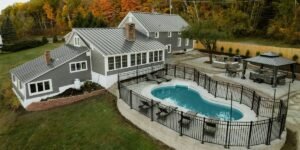For a long time, retail properties were primarily places where people went simply to buy things. However, with the significant growth of online shopping and changing consumer preferences, physical retail spaces have been undergoing a fascinating transformation. It’s no longer just about shelving products; it’s about creating engaging environments that offer much more than just a transaction. This evolution is shaping how we interact with stores and how communities are designed.
This article will explore how physical retail properties are adapting to the digital age. We’ll chat about the shift towards creating memorable experiences, how the online and offline shopping worlds are blending, the rise of retail as part of larger community hubs, and how spaces are becoming more flexible to meet changing needs.
Read also: How to Plan Retail Spaces for Higher Customer Engagement
More Than Just Shopping: The Shift to Experiences
One of the biggest changes in retail properties is the move from pure shopping to creating engaging experiences. With the convenience of online purchasing, physical stores have had to offer a compelling reason for people to visit in person. This often means providing unique interactions, entertainment, or services that can’t be easily replicated on a screen. Retailers are investing in creative displays, interactive technologies, and spaces where people can learn, play, or simply spend time.
Think about stores that host workshops, offer tasting events, or provide lounge areas for socializing. These are designed to be destinations where visitors can enjoy themselves, explore, and perhaps even discover new interests, rather than just grabbing an item and leaving. This emphasis on the “experience” makes a visit worthwhile and helps build a stronger connection between the consumer and the physical space, turning a simple errand into an outing.
Blending Worlds: Physical and Digital Integration
The lines between online and physical shopping have become increasingly blurred, and retail properties are adapting by integrating both worlds. Many stores now serve as hubs for online orders, offering services like “click-and-collect” or “buy online, pick up in store,” which provide convenience for shoppers. This means a customer can browse products from home and simply pop into the store to quickly pick up their purchase, combining the best of both worlds.
Physical stores are also becoming places where customers can easily return online purchases, making the overall shopping experience smoother. Furthermore, technology within the physical space is becoming more common. This can include digital screens that provide product information, interactive mirrors, or augmented reality tools that help customers visualize products. These integrations ensure that the physical storefront complements and enhances the digital shopping journey, rather than competing directly with it.
Community Hubs: The Rise of Mixed-Use Developments
Retail properties are increasingly becoming part of larger, mixed-use developments that blend shopping with residential, office, and entertainment spaces. These developments are designed to create vibrant community hubs where people can live, work, and play all within the same area. The retail component in these projects often focuses on amenities that serve the local residents and workers, as well as drawing visitors from further afield.
Imagine a complex that includes apartments, office buildings, green spaces, and a variety of shops and restaurants, all within walking distance. This setup encourages people to spend more time in the area, leading to more frequent visits to the retail establishments. The retail spaces often become central gathering points, fostering a sense of community and providing convenient access to everyday needs and leisure activities, making them integral to the fabric of modern urban living.
Read also: Exploring Types of Commercial Properties: Office Buildings, Retail Spaces, Warehouses, and More
Flexible Spaces: Adapting to Changing Consumer Needs
Another significant evolution in retail properties is the trend towards more flexible spaces. Retailers are looking for ways to adapt quickly to changing consumer tastes and seasonal demands, and property owners are responding with more adaptable lease structures and building designs. This can include spaces designed for pop-up shops, allowing brands to test new markets or concepts without long-term commitments.
Temporary leases for seasonal events or experiential installations are also becoming more common, bringing a fresh and dynamic feel to retail environments. The physical layouts within stores themselves are often designed to be reconfigurable, allowing retailers to easily change displays, introduce new product lines, or host special events. This flexibility ensures that retail properties can remain relevant and responsive in a fast-paced market, offering consumers new reasons to visit and explore.











